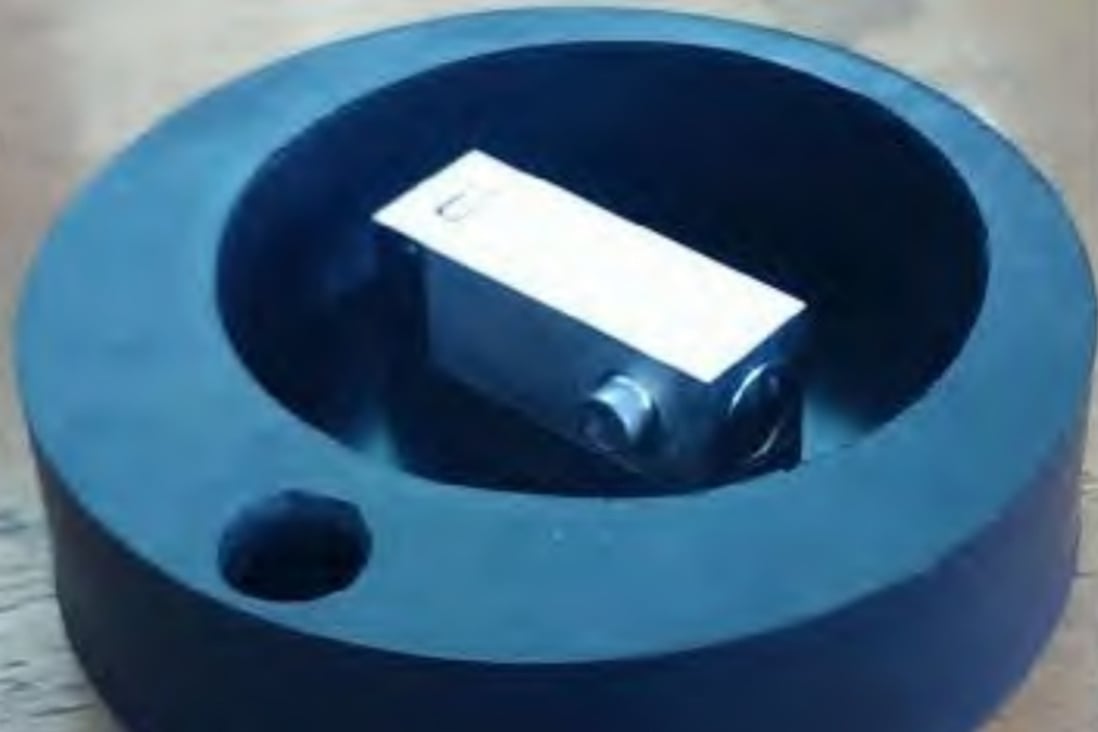Chinese scientists say new stealth tech for submarines can ‘cancel out’ US Navy sonar
Sound-emitting tile made of costly rare earth elements can turn powerful US sonar tech against itself, Beijing researchers say
Low-frequency, high-decibel sound produced can cause enemy sonar operator to mistake the submarine for water, team says in paper
The lightweight, ‘active’ device developed by the Chinese team is based on giant magnetostrictive material technology. Credit: Beijing Institute of Technology
A research team in China says it has created a new coating device that could help submarines evade advanced enemy sonar by mimicking water.
The tile-like device can analyse enemy sonar frequency, and generate opposing sound waves to cause the sonar operator to mistake the submarine for water, the researchers said.
Low-frequency sounds produced by the tiles can reach an intensity of up to 147 decibels, which is louder than a rock concert and sufficient to “cancel out” some of the most powerful active sonars used by the US military or its allies, according to the team from the Beijing Institute of Technology.
A complete unit of the device is less than half the size and thickness of a brick, allowing engineers to stick them all over the hull of a submarine to tackle sonar beams from different directions.
“The submarine surface coating widely used by the world’s naval powers is the anechoic tile,” the researchers said in their paper published in Chinese-language peer-reviewed journal Acta Armamentarii last month.
These “passive” sound-absorbing tiles, made of rubber or synthetic polymer, are usually less than 7 centimetres (2.8 inches) thick, and work best against sonar signals in a higher frequency range with wavelengths shorter than their thickness.
But they may not be as effective against longer wavelengths, and therefore lower frequencies, as the two are inversely proportional.
“The frequency of modern active sonars is getting lower and lower, with wavelengths exceeding one metre,” lead researcher Wang Wenjie and his colleagues said in their paper.
“The passive coating can no longer meet the combat requirements of a quiet submarine, no matter how you change the material composition and structure of the tiles.”
The “active” tile developed by the Beijing Institute team is based on giant magnetostrictive material (GMM) technology, named after a phenomenon discovered by 19th century British physicist James Joule.
In 1842, Joule was the first to observe that some materials expand or shrink when placed near a magnet, in an effect known as “magnetostriction”.
For more than a century, the discovery was viewed as interesting but useless, because the magnet-induced changes were too small for any serious applications.
In the 1970s, scientists with the US Navy invented the alloy Terfenol-D, the first GMM that could convert magnetic force into mechanical energy – leading to visible changes in shape.
Due to its high power output and efficiency, Terfenol-D is used in key driving components for active sonars on many US warships, according to Wang’s team.
But the application of the technology remains limited, because manufacturing GMM requires a large amount of expensive and heavy rare earth elements – such as terbium and dysprosium – whose reserves are mostly concentrated in China.
Wang’s and his colleagues said their device could turn the US active sonar technology against itself.
The challenge was to pack all the components into a small format while maintaining high power output. Active acoustic stealth prototypes that came before were “tens of times bigger than ours,” the team said.
The researchers also spent a lot of time improving the device’s engineering design to make it suitable for quick installation, long-term operation and maintenance on submarines in deep oceans.
“The emission unit is lightweight, operable in a wide range of frequencies with high efficiency, and resistant to pressure,” the paper said.
While the team did not disclose the cost and rare earth composition of the giant magnetostrictive components of the device, it said the technology would “find broad application in cladding of active acoustic arrays on large-scale submarines”.
Some critical rare earth elements, including dysprosium, are in short supply due to the rapid growth of electric car production in China, according to recent Chinese media reports.

